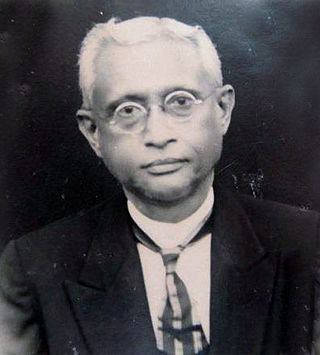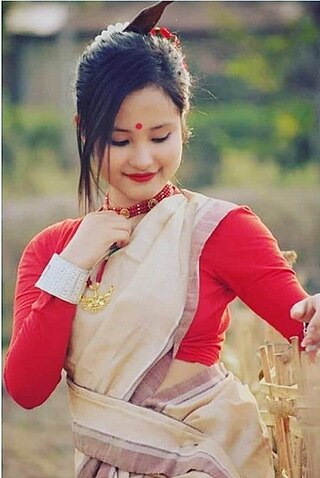
Bihu is a set of three important cultural festivals unique to the Indian state of Assam – 'Rongali' or 'Bohag Bihu' observed in April, 'Kongali' or 'Kati Bihu' observed in October or November, and 'Bhogali' or 'Magh Bihu' observed in January. The festivals present an admixture of Tibeto-Burman, Austroasiatic and Indo-Aryan traditions entwined so intricately that it is impossible to separate them—festivals which are uniquely Assamese to which all communities of Assam had contributed elements. The Rongali Bihu is the most important of the three, celebrating spring festival. The Bhogali Bihu or the Magh Bihu is a harvest festival, with community feasts. The Kongali Bihu or the Kati Bihu is the sombre, thrifty one reflecting a season of short supplies and is an animistic festival.
The Navajo song ceremonial complex is a spiritual practice used by certain Navajo ceremonial people to restore and maintain balance and harmony in the lives of the people. One half of the ceremonial complex is the Blessing Way, while the other half is the Enemy Way.

Assamese cinema, is an Indian film industry of Assamese-language. It is based in Assam, India. The industry was born in 1935 when Jyoti Prasad Agarwala released his movie Joymoti. Since then the Assamese cinema has developed a slow-paced, sensitive style. In beginning the industry were called Jollywood, named for Agarwala's Jyoti Chitraban Film Studio.

A Vivaha Mandapa, also referred to as Kalyana Mandapa or simply Wedding mandapa is a mandapa (pavilion) temporarily erected for the purpose of a Hindu or Jain wedding. It is the term used for the wedding canopy in Dharmic religions. The main wedding ceremonies take place under this mandapa. Vivaha Mandapas have historically also been featured adjacent to Hindu temples to commemorate the wedding of Hindu deities, such as Rama and Sita.

Kalita is an ethnic group or a caste of Assamese Hindus belonging to the state of Assam in North East India. Kalita is a forward caste and belongs to General or Unreserved category. Kalita represents a category in the tribe-caste continuum of Assamese society that is placed between the Keot on one side and Ganak and Brahmin on the other. According to historians like S.L.Barua, Kalitas started migrating from North and East India to Assam during the 11th century rule of Dharmapal.
The seclusion of girls at puberty has been practised in societies around the world, especially prior to the early 20th century. In such cultures, girls' puberty held more significance than boys' due to menstruation, the girl's potential for giving birth, and widespread ideas of ritual purification related to the sacred power of blood. These societies practised various rites of passage, many of which lost their original forms or completely disappeared with the emergence of modern trends such as industrialization.

Half sari function or Langa Voni Telugu: లంగా ఓణి, Pavadai Dhavani Tamil: பாவாடை தாவணி, Langa Davani Kannada: ಲಂಗ ದಾವಣಿ. In South Indian Hindu tradition, the Ritu Kala Samskara ceremony or Ritushuddhi is a ceremony performed when a girl wears a sari for the first time because. It is the celebration of when a girl's rite of passage after menarche or period, and she is deemed a young woman both physically and spiritually. Langa voni is traditional clothing for unmarried girls in South India.

Ihi, Ehee is a ceremony in the Newar community in Nepal in which pre-adolescent girls are "married" to the Suvarna Kumar which is a symbol of the god Vishnu, ensuring that the girl becomes and remains fertile. It is believed that if the girl's husband dies later in her life, she is not considered a widow because she is married to Vishnu, and so already has a husband that is believed to be still alive. This was basically done to dodge the tradition of 'Sati Pratha', where after the husband dies, the widow sacrifices herself in the burning fire.
Bahaghara is a wedding ceremony performed by Odia Hindu people in the Indian state of Odisha. There are subtle differences in the rites observed by different castes. In Odia marriage rituals, the mother of the bridegroom does not take part in the ceremony. The Utkala Brahmins have their weddings only in the daytime, preferably at midday or in the morning, while the other caste weddings are done during the evening or night. There is the custom of sending betel nuts to family friends for inviting them to the marriage. The first invitation is sent to the family deity as a respect to the lord. Marriages in Odisha are mostly fixed and arranged by the parents. Marriages for serving or capturing is not common.

Nalini Bala Devi was an Indian writer and poet of Assamese literature, known for nationalistic as well as mystical poetry. She was awarded the Padma Shri by the Government of India in 1957 for her contribution to literature, and 1968 she won the Sahitya Akademi Award given by Sahitya Akademi for her poetry collection Alakananda. She is the first woman Assamese poet to be awarded with Padma Shri and the first lady to the chair the Assam Sahitya Sabha.

Chandradhar Barua was a writer, poet, dramatist and lyricist from Assam of Jonaki Era, the age of romanticism of Assamese literature. Barua was born at Dergaon, Golaghat, Assam on 15 October 1878. He was second president of the Asam Sahitya Sabha in 1918 held at Goalpara. He was the founder secretary of Asam Sahitya Sabha Patrika, an official journal of the Asam Sahitya Sabha established at 1927 and held in that position till 1936. He also represented India at the Round Table Conference held at London in 1930.
Ananda Chandra Barua (1907–1983) was a writer, poet, playwright, translator, journalist and actor from Assam. He is popularly known as Bokulbonor Kobi in Assamese literacy society. He was honoured with, most notably the Padma Shri title and Sahitya Akademi award.
Rai Bahadur Surya Kumar Bhuyan MBE (1892–1964) was a writer, historian, educator, social activist, storyteller, essayist, professor and a poet from Assam. He has written many books on ancient history, stories, essays, biographies, etc. in the world of Assamese literature. He presided over the Asam Sahitya Sabha (1953) held at Shillong. He was the elected member of Rajya Sabha during 1952–53, and was awarded the Padma Shri by the Government of India in 1956.

Professor Maheswar Neog was an Indian academic who specialised in the cultural history of the North East India especially Assam, besides being an Assamese-language scholar and poet. He was a top Indologist, and his work covers all disciplines of Indian studies, folk-lore, language, dance, history, music, religion, drama, fine arts, paintings, historiography and hagiography, lexicography and orthography, epigraphy and ethnography. His research includes multi-dimensional features of Vaishnava renaissance in Assam through Srimanta Sankardev, Madhabdev, Damodardev, Haridev, Bhattadev and other Vaishnava saints of Assam.

The Chutia people are an ethnic group that are native to Assam and historically associated with the Chutia kingdom. However, after the kingdom was absorbed into the Ahom kingdom in 1523–24, the Chutia population was widely displaced and dispersed in other parts of Upper Assam as well as Central Assam. They constitute one of the core groups that form the Assamese people.

The Thengal Kachari people are an indigenous ethnic group of Assam, India. They are a part of greater Bodo-Kachari family.They are manily concentrated in the Jorhat, Golaghat, North Lakhimpur, Nagaon and Karbi Anglong districts.Their traditional festival is "Tora Chira" bihu.They commonly known as "Kachari" people.
Pushpalata Das (1915–2003) was an Indian independence activist, social worker, Gandhian and legislator from the north-east Indian state of Assam. She was a member of Rajya Sabha from 1951 to 1961, a member of the Assam Legislative Assembly and a member of the working committee of the Indian National Congress. She served as the chairperson of the Assam chapters of the Kasturba Gandhi National Memorial Trust and Khadi and Village Industries Commission. The Government of India awarded her the third highest civilian honour of the Padma Bhushan, in 1999, for her contributions to society.

Assamese Brahmins are the Brahmins present in the Assamese society. There they promoted learning, Vedic religion, astrology, ayurveda and as well as imparting general vedic knowledge to the public. The Brahmins migrated to Assam from Videha (Mithila), Kannauj, Bengal and many other places.
A menstruation celebration, first moon party, or period party, celebrates menstruation. Different cultures and communities across the globe celebrate Menarche. This practice is followed by Apache, Ojibwe and Hupa tribal communities from different parts of North America, Ulithi tribe from South Pacific region, Japan, Africa, and India among others.
Bhekuli Biya, also known as frog marriage, is a traditional practice deeply rooted in Assam, India. Also referred to as "Mandooka Parinaya" and "Banger Biye" in various regions of India, this ritual takes place during the dry summer months with the aim of invoking rain.












